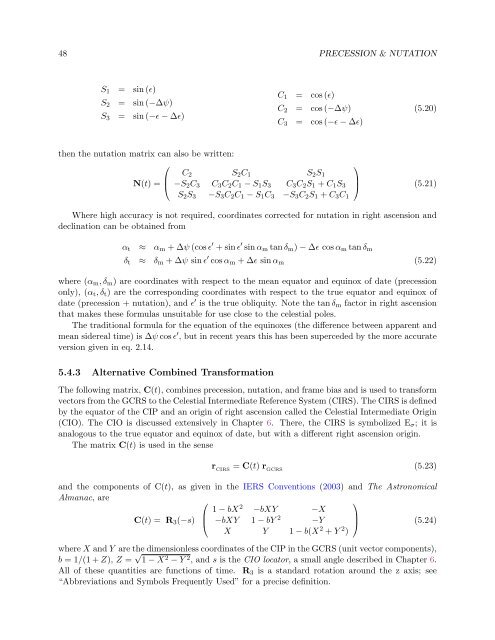USNO Circular 179 - U.S. Naval Observatory
USNO Circular 179 - U.S. Naval Observatory
USNO Circular 179 - U.S. Naval Observatory
Create successful ePaper yourself
Turn your PDF publications into a flip-book with our unique Google optimized e-Paper software.
48 PRECESSION & NUTATION<br />
S1 = sin (ɛ)<br />
S2 = sin (−∆ψ)<br />
S3 = sin (−ɛ − ∆ɛ)<br />
then the nutation matrix can also be written:<br />
⎛<br />
N(t) =<br />
⎜<br />
⎝<br />
C1 = cos (ɛ)<br />
C2 = cos (−∆ψ) (5.20)<br />
C3 = cos (−ɛ − ∆ɛ)<br />
C2 S2C1 S2S1<br />
−S2C3 C3C2C1 − S1S3 C3C2S1 + C1S3<br />
S2S3 −S3C2C1 − S1C3 −S3C2S1 + C3C1<br />
⎞<br />
⎟<br />
⎠ (5.21)<br />
Where high accuracy is not required, coordinates corrected for nutation in right ascension and<br />
declination can be obtained from<br />
αt ≈ αm + ∆ψ (cos ɛ ′ + sin ɛ ′ sin αm tan δm) − ∆ɛ cos αm tan δm<br />
δt ≈ δm + ∆ψ sin ɛ ′ cos αm + ∆ɛ sin αm (5.22)<br />
where (αm, δm) are coordinates with respect to the mean equator and equinox of date (precession<br />
only), (αt, δt) are the corresponding coordinates with respect to the true equator and equinox of<br />
date (precession + nutation), and ɛ ′ is the true obliquity. Note the tan δm factor in right ascension<br />
that makes these formulas unsuitable for use close to the celestial poles.<br />
The traditional formula for the equation of the equinoxes (the difference between apparent and<br />
mean sidereal time) is ∆ψ cos ɛ ′ , but in recent years this has been superceded by the more accurate<br />
version given in eq. 2.14.<br />
5.4.3 Alternative Combined Transformation<br />
The following matrix, C(t), combines precession, nutation, and frame bias and is used to transform<br />
vectors from the GCRS to the Celestial Intermediate Reference System (CIRS). The CIRS is defined<br />
by the equator of the CIP and an origin of right ascension called the Celestial Intermediate Origin<br />
(CIO). The CIO is discussed extensively in Chapter 6. There, the CIRS is symbolized Eσ; it is<br />
analogous to the true equator and equinox of date, but with a different right ascension origin.<br />
The matrix C(t) is used in the sense<br />
r CIRS = C(t) r GCRS<br />
(5.23)<br />
and the components of C(t), as given in the IERS Conventions (2003) and The Astronomical<br />
Almanac, are<br />
⎛<br />
⎞<br />
C(t) = R3(−s)<br />
⎜<br />
⎝<br />
1 − bX 2 −bXY −X<br />
−bXY 1 − bY 2 −Y<br />
X Y 1 − b(X 2 + Y 2 )<br />
⎟<br />
⎠ (5.24)<br />
where X and Y are the dimensionless coordinates of the CIP in the GCRS (unit vector components),<br />
b = 1/(1 + Z), Z = √ 1 − X 2 − Y 2 , and s is the CIO locator, a small angle described in Chapter 6.<br />
All of these quantities are functions of time. R3 is a standard rotation around the z axis; see<br />
“Abbreviations and Symbols Frequently Used” for a precise definition.


